Moth Dust Rubbish Poison Mice
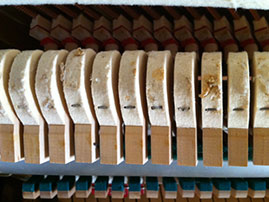 Specialized wool-based felts and cloths in all kinds of densities and weights, as well as leathers, are made to an accuracy of one tenth of a millimetre especially for the piano industry. These beautiful but expensive materials are glued to many parts in the piano, and play a critical role in tone production, touch, and the performance of the keys and action mechanism.
Specialized wool-based felts and cloths in all kinds of densities and weights, as well as leathers, are made to an accuracy of one tenth of a millimetre especially for the piano industry. These beautiful but expensive materials are glued to many parts in the piano, and play a critical role in tone production, touch, and the performance of the keys and action mechanism.
Dense felts fastened around the hammers, which hinge in ingenious precision bearings, travel thousands of times faultlessly the same path to the strings. Between the keys and strings is a complex, intricate but durable mechanism that, depending on the amount of playing, is liable to wear. Unaware owners often realize far too late that moth larvae, silverfish or mice are eating costly cloths and felts, devaluating and compromising the performance of their instrument. Even when a piano is not played at all, it is always prone to be infested by pests. (Above: moth-eaten hammers).


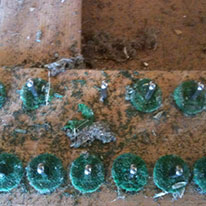
Above: Dust, rubbish under keys, and moth-eaten keyboard cloths.
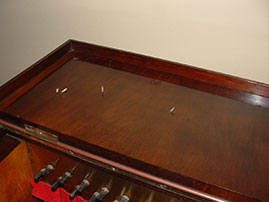
Above: Moth larvae sacks hanging down from the top lid of an upright piano.
Below: Hammers eaten by this mouse. The green specs are moth larvae eating cloth.
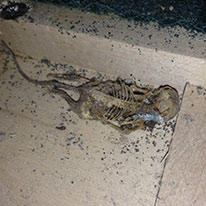
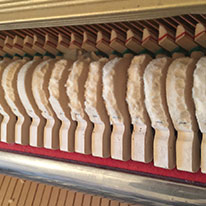
Replacing expensive pest damaged felts and cloths is very labour intensive and time-consuming work. It can cost thousands of dollars, as the keyboard and action mechanism often need to be totally regulated after cloths or felts are replaced. The cost of a cleaning and lubricating service once every 3 to 5 years is much better for your bank balance and piano. Missing regular tunings and services is neglect, false economy, bad for your piano, bad for the development of your hearing and playing technique.
During a service, the entire piano and action mechanism is cleansed of dust, moth and other pests. All cloths and felts are moth treated, pedals and other parts lubricated with special lubricants, and the action mechanism and keyboard are regulated. The instrument is tuned and finally, all hammerheads are voiced to obtain an even and correct quality of tone to the preference of the owner and surrounding acoustics. Work on the piano can, as a rule be done in the home, saving transport costs, but the action mechanism is usually taken to the workshop. Cleaning and maintenance work to the action mechanism can be done to a higher standard in the workshop, where all tools, equipment, materials and space are available, also avoiding breathing in unhealthy dust and old poisonous pesticides such as DDT in the client’s home.
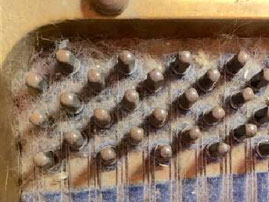 When the lid of a grand piano is continuously left open, dust and rubbish such as debris from erasers, pencil lead, paperclips, bits of paper, cat hair, etc. falls onto the tuning pins, frame, strings, dampers, soundboard, and into the action mechanism, right down to the key-bed under the keys. It accumulates inside the piano, and interferes with the performance of the keys and action mechanism. The strings are more exposed and will rust, and all this contributes to a poorly performing piano and deterioration in tone. Never allow a cat on the keys or inside your piano, they mark their territory and do damage.
When the lid of a grand piano is continuously left open, dust and rubbish such as debris from erasers, pencil lead, paperclips, bits of paper, cat hair, etc. falls onto the tuning pins, frame, strings, dampers, soundboard, and into the action mechanism, right down to the key-bed under the keys. It accumulates inside the piano, and interferes with the performance of the keys and action mechanism. The strings are more exposed and will rust, and all this contributes to a poorly performing piano and deterioration in tone. Never allow a cat on the keys or inside your piano, they mark their territory and do damage.

